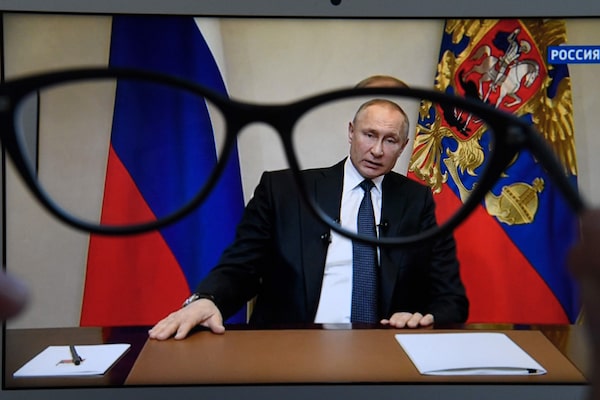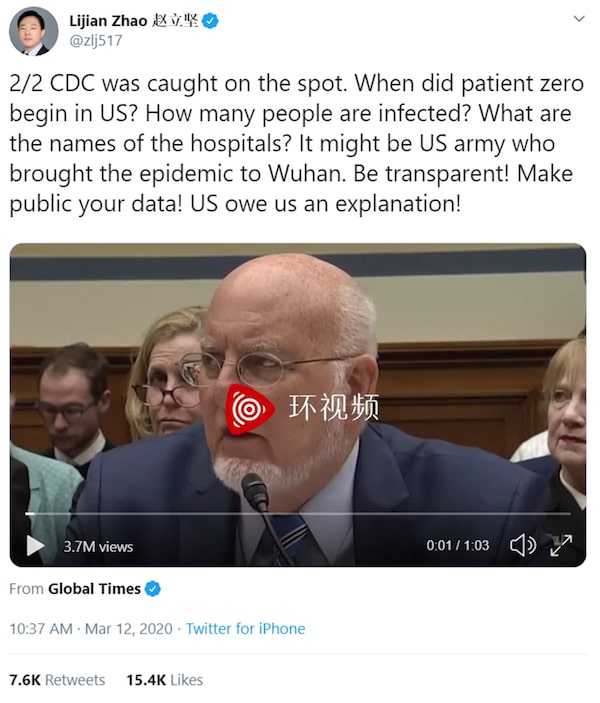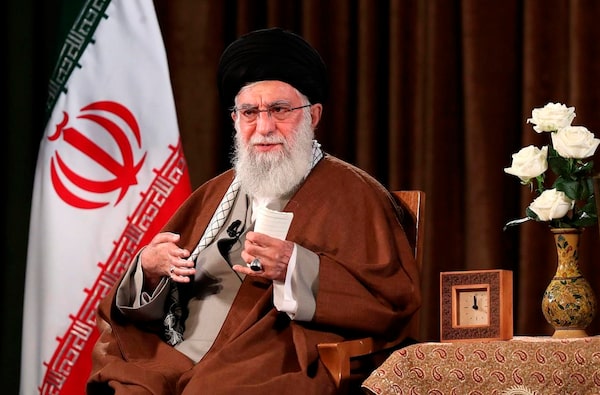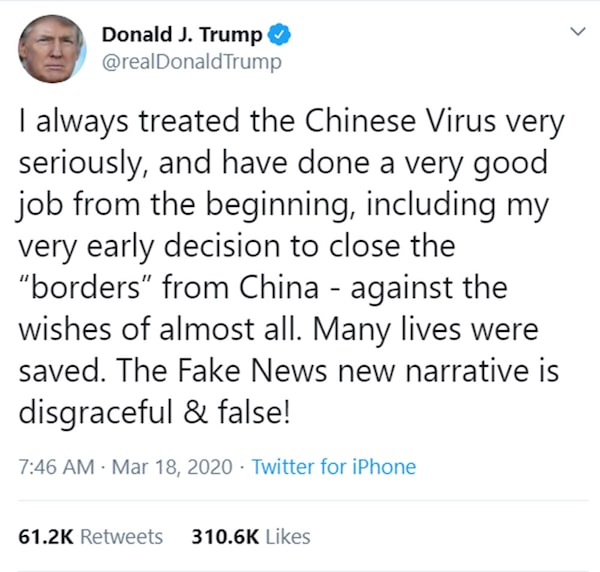
Moscow, March 25: A woman watches a live address to the nation from Russian President Vladimir Putin about the coronavirus pandemic.KIRILL KUDRYAVTSEV/AFP via Getty Images/AFP/Getty Images
Russia and China have launched what experts say are disinformation campaigns against the West, seeking to change the global narrative about where the coronavirus pandemic originated, and which countries are leading the fight against it.
The subplot to the stories Moscow and Beijing are selling is one of Western societies in decline, with authoritarian systems proving themselves superior to democratic ones in managing the crisis.
A report prepared earlier this month for the European Union pointed the finger at both Russia and China for their roles in feeding an “infodemic” of untrustworthy information about COVID-19.
State-sponsored disinformation is different from some of the simpler hoaxes being spread online – including a lot of bad, or unproven, advice about how to avoid or treat the virus – in that it is being spread to advance geopolitical aims.
The virus that causes COVID-19 is spread through airborne droplets by coughing or sneezing, through touching a surface those droplets have touched, or through personal contact with infected people.
Wash your hands frequently and thoroughly
The World Health Organization recommends regular hand-washing and physical distancing – that is, keeping at least two metres from someone with a cough. If you have to cough or sneeze, do it into your sleeve or a tissue, not your hands. Avoid touching your eyes, mouth or nose if you can.
The CDC says to frequently clean dirty surfaces with soap and water before disinfecting them.
- If you show symptoms of COVID-19, seek medical attention and do what your health-care provider recommends. That may include staying home from work or school and getting lots of rest until the symptoms go away.
COVID-19 is much more serious for older adults. As a precaution, older adults should continue frequent and thorough hand-washing, and avoid exposure to people with respiratory symptoms.
Check the WHO’s information page for more details on the virus, and The Globe and Mail’s guide of what health officials say is helpful for the public to do or not do about it.
Need more answers? Email audience@globeandmail.com
As of Friday, the European External Action Service, an arm of the EU tasked with combating propaganda, had compiled a list of 162 examples of coronavirus-related disinformation, which it traced to pro-Kremlin media outlets or social-media accounts.
One report on a pro-Kremlin website said “those with money” had unleashed “secret germ warfare” on the rest of the world. Another claimed that the pandemic had forced the closing of the metro in the Ukrainian city of Lviv. Lviv does not have a metro.
For Russia, the effort to sow chaos is seen as an extension of the “hybrid war” – an undeclared conflict fought in the military, economic and information spheres – that it has been waging against the West since 2014, when Moscow’s annexation of the Crimean Peninsula from Ukraine made it the target of crippling economic sanctions imposed by Canada, the United States and the European Union. Victory for Moscow means breaking Western solidarity, and bringing the sanctions to an end, while keeping Crimea.
Analysts say Beijing’s aims are even loftier, with an eye to replacing Washington as the preeminent global power – the capital other countries look to for leadership.
“Russia would like to see the EU divided, and to pick off some of the countries like Italy,” turning them from pro-U.S. to pro-Kremlin, said Agnieszka Legucka, a senior research fellow on Russia at the Polish Institute of International Affairs.
“Russia is also transferring Chinese disinformation and propaganda that Western democracies are not able to help and save their people, that only strong countries like Russia and China are able to manage the coronavirus.”
Wuhan, March 10: A screen at a near-empty shopping centre broadcasts Chinese President Xi Jinping's visit to the epicentre of China's COVID-19 epidemic.Thomas Peter/Reuters/Reuters

Zhao Lijian, a spokesman for the Chinese foreign ministry, has amplified conspiracy theories on Twitter that the virus was introduced to Wuhan by the U.S. military.Twitter
A key piece of disinformation spread by both China and Russia – and then repeated by friendly governments such as Iran’s – is a baseless accusation that the coronavirus, which originated in December in a seafood and live animal market in the Chinese city of Wuhan, was instead a U.S. military bioweapon gone awry.
In China’s favoured telling of that story, COVID-19 was actually brought to Wuhan by infected U.S. military personnel who attended the Military World Games in October. That version was given prominence by Zhao Lijian, a spokesman for the Chinese foreign ministry, who retweeted an article published by a Montreal-based website known for propagating conspiracy theories and pro-Russian disinformation.
“It might be US army who brought the epidemic to Wuhan. Be transparent! Make public your data! US owe us an explanation!” Mr. Zhao wrote in another tweet.
Russian media have pushed out a similar tale with a local twist. REN TV, a channel controlled by Kremlin-friendly businesspeople, carried its own evidence-free report blaming the U.S. government for coronavirus, but switched the point of origin to the U.S.-funded Lugar Research Center in the former Soviet republic of Georgia, a country where Washington and Moscow have spent decades wrestling for influence.
“This is propaganda. What can we do?” Paata Imnadze, the director of Lugar, told Coda Story, a news website based in the Georgian capital city of Tbilisi. The Lugar lab has actually led the Georgian government’s response to the coronavirus pandemic.
Kremlin spokesman Dmitry Peskov has called the EU report on Russian-sponsored coronavirus disinformation “unfounded allegations which in the current situation are probably the result of an anti-Russian obsession.”

Tehran, March 22: Supreme Leader Ayatollah Ali Khamenei addresses Iranians in a televised speech.Office of the Iranian Supreme Leader via AP/The Canadian Press
The unfounded allegations about the U.S. military creating COVID-19 have also been pushed along by Iran’s Ayatollah Ali Khamenei, who said it was one of the reasons his country could not accept an American offer of help dealing with the crisis.
“You’re accused of having created coronavirus. I don’t know how true it is. But when there’s such an allegation, can a wise man trust you?” read a posting on his English-language Twitter account.
Bill Bishop, an expert on Chinese media, said Beijing was equally keen to muddy the waters about the origins of COVID-19, both for domestic political purposes, and to protect the country’s international reputation.
At home, the Communist Party regime had successfully – via social-media networks that are tightly controlled by state censors – persuaded many Chinese to blame a foreign enemy for the outbreak, rather than their own government.
The fact that an official foreign ministry spokesman helped spread the same disinformation on Twitter (a platform that is blocked inside China), suggests that the effort to push out an alternative narrative about the origins of COVID-19 was directed from the very top.
“Zhao Lijian would not be doing this if he didn’t believe that he had approval to do this stuff,” said Mr. Bishop, who edits the Sinocism e-newsletter, which is popular with China-focused academics. “And if you look at how the system works – people who censor all the time are not censoring this.”

U.S. President Donald Trump has frequently called COVID-19 a 'Chinese virus' despite advice that this inflames anti-Asian racism.Twitter/Twitter
The Chinese effort to rewrite the virus’s origin story were partly defensive. Mr. Zhao’s inflammatory tweets came two days after U.S. President Donald Trump first retweeted a post referring to COVID-19 as the “China Virus.” Mr. Trump has since made a point, on Twitter and during televised news conferences, of referring to the disease as the “Chinese virus.”
Mr. Trump promised this week to stop using such language – after a rise in racist attacks targeting Asian-Americans – but he made it clear that he believed he was only fighting his corner in a propaganda war. “I don’t regret it, but they accused us of having done it through our soldiers, they said our soldiers did it on purpose, what kind of a thing is that?” he told Fox News on Tuesday.
But a day after Mr. Trump made his promise to stop using the racially charged term, G-7 foreign ministers were unable to agree on a joint statement on the coronavirus outbreak because of a U.S. insistence on including the term “Wuhan virus.”
Mr. Trump has himself been accused of spreading unproven and unsafe medical ideas by using his press conferences to talk about potential coronavirus remedies that have not yet been tested. However, experts say that his remarks have generally fallen into the category of bad advice, rather than a state-sponsored propaganda campaign.
Belgrade, March 21: Crew members wave Chinese and Serbian flags after medical experts from China arrived with supplies to help the Balkan nation fight the coronavirus.Marko Djurica/Reuters/Reuters
Beyond blurring the origin story, Russian and Chinese outlets – as well as social-media accounts that reliably parrot them – have also sought to give the impression that Moscow and Beijing are leading the world both in terms of managing the pandemic, and in lending a helping hand to others.
China, the country that was hit first and, initially, hardest, is now keen to show that it has the virus under control, with cities such as Beijing and even Wuhan returning to normal as the rates of deaths and new infections slow.
The Kremlin, meanwhile, had until this week resisted the lockdown measures adopted by many other countries, pointing to its relatively low infection rate, and the fact that only one death in Russia has been officially attributed to coronavirus. That narrative has changed only in the past few days, as the number of infections has shot up, causing President Vladimir Putin to order a one-week work stoppage next week to contain the spread of the virus.
Mr. Putin also indefinitely postponed an April 22 referendum on constitutional changes, which, if the measures pass, would give him the ability to remain in power until 2036.
Maria Snegovaya, a post-doctoral research fellow at Johns Hopkins University who focuses on Russia and Eastern Europe, said the public should be skeptical about both China’s and Russia’s versions of the story.
“Definitely, we should not trust the data that comes from authoritarian regimes. This is somewhat true about China, and particularly true about Russia,” she said, pointing to how the Soviet Union initially denied there had been nuclear disaster at Chernobyl in 1986, and how Mr. Putin’s own government lied for days about the sinking of the Kursk nuclear submarine in 2001.
Tied into the idea that China and Russia are handling their own coronavirus problems better than the West are their showy donations of medical aid to crisis-stricken Italy and Spain, which have seen the world’s deadliest outbreaks to date.
“The way this is portrayed in pro-Russian media is, ‘See, the EU is so weak and the U.S. is unreliable. Only Russia and China are coming to help them,’ ” said Ms. Snegovaya. “It’s a typical [Russian security services] disinformation campaign. It’s very convenient that the West is weakened at this moment, so you try to undermine it further.”
But after days of headlines about Russia and China helping where Brussels could not, Italy’s La Stampa newspaper reported Thursday that 80 per cent of the medical help delivered by Russia, which included disinfection equipment, was “useless.” Spain’s Health Ministry, meanwhile, found that test kits donated by China weren’t sensitive enough to detect most coronavirus cases, and decided to return them.
 Mark MacKinnon
Mark MacKinnon